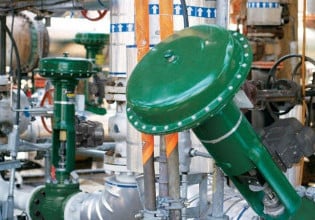HexaTech Inc. announced today that it has received a continuation of funding under the U.S. Department of Energy's (DoE) Advanced Research Projects Agency (ARPA-E) development program. The cost-share extension is valued at $1.2 million over 1 year, and follows $2.8 million over 2 years when the contract was initiated in 2012.
The HexaTech contract focuses on the development of high-power semiconductor switching devices based on Aluminum Nitride (AlN) to more efficiently control the flow of electricity across high-voltage electrical lines. AlN-based devices should exceed the capabilities of currently used materials, enabling smaller, more reliable components. The further implementation of these components could decrease the cost of electricity transmission while increasing overall grid security and reliability.
HexaTech CEO John Goehrke noted, "This contract extension will allow us to further expand our market leadership in high power AlN device development. Combined with ARPA-E's unique Tech-To-Market concept, we anticipate not only raising the bar in device performance, but also raising awareness for AlN in general, which will in turn be a significant growth opportunity for our core substrate business."
"This continued support from ARPA-E will allow us to demonstrate the potential of AlN for high voltage devices by optimizing MOCVD growth parameters, as well as fabricating and testing commercially-oriented components", commented Dr. Baxter Moody, Principal Investigator for the program at HexaTech. He added "HexaTech's world-leading, high quality bulk AlN substrates are the ideal foundation for supporting these designs, and will be essential to maximize high power semiconductor device performance in the future."
“For example, at a specific on resistance of 10-3 Ohm•cm2, the Breakdown Voltage of silicon would be 100 V, for 4H-SiC it would be 4000 V, for GaN it would be 5000 V, while for AlN it would be 20000V! This indicates a more than 5:1 performance improvement over SiC and a 200:1 improvement over Si if the full potential of AlN is realized,†Moody commented in an earlier interview with PowerPulse.
Moody compared AlN high-voltage power devices to devices fabricated with SiC and claims that the AlN devices are produced with a blocking layer 65% to 75% thinner than that needed for SiC, making them more manufacturable, higher yielding, and lower cost. The AlN devices can operate faster than SiC GTOs and IGBTs since they are majority carrier devices and majority carrier devices are faster, particularly during turn off, which is delayed due to minority carrier storage. Resulting in the expectation that AlN devices will operate more efficiently than SiC GTOs and IGBTs since these bipolar devices will exhibit loss during the turn off due, again a result of minority carrier storage.
“AlN-based power devices provide: Exceptionally high breakdown voltage…Beyond 20 kV. Dramatically lower resistive losses, with increased efficiencies and greater energy savings. Switching frequencies above 20 kHz. Operation at higher junction temperatures. And lower cost. For example, in 20-kV diode application we estimate that an AlN device will be about 50% lower equivalent cost compared to either unipolar or bipolar SiC devices, while simultaneously delivering greater performance,†Moody concluded.






